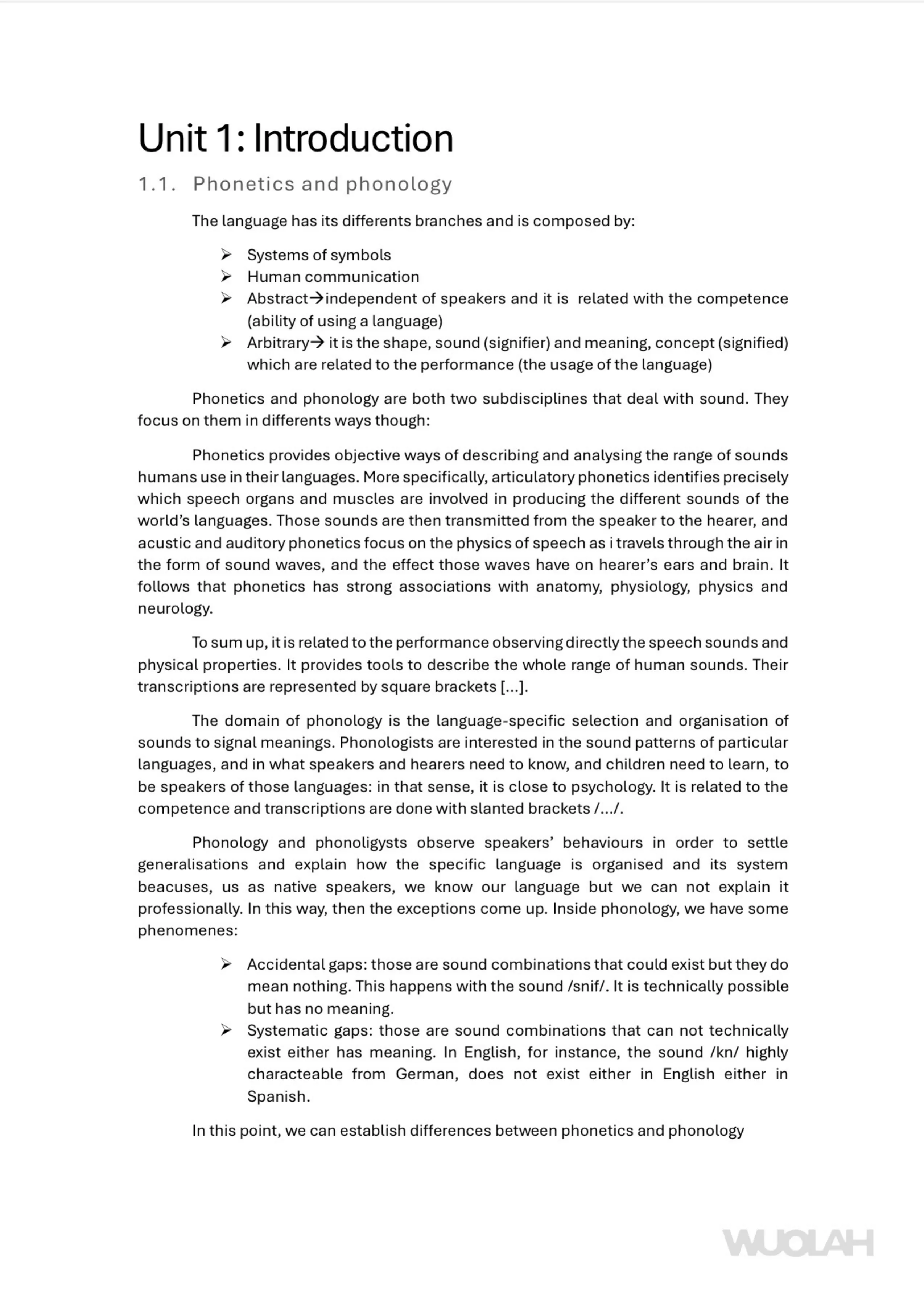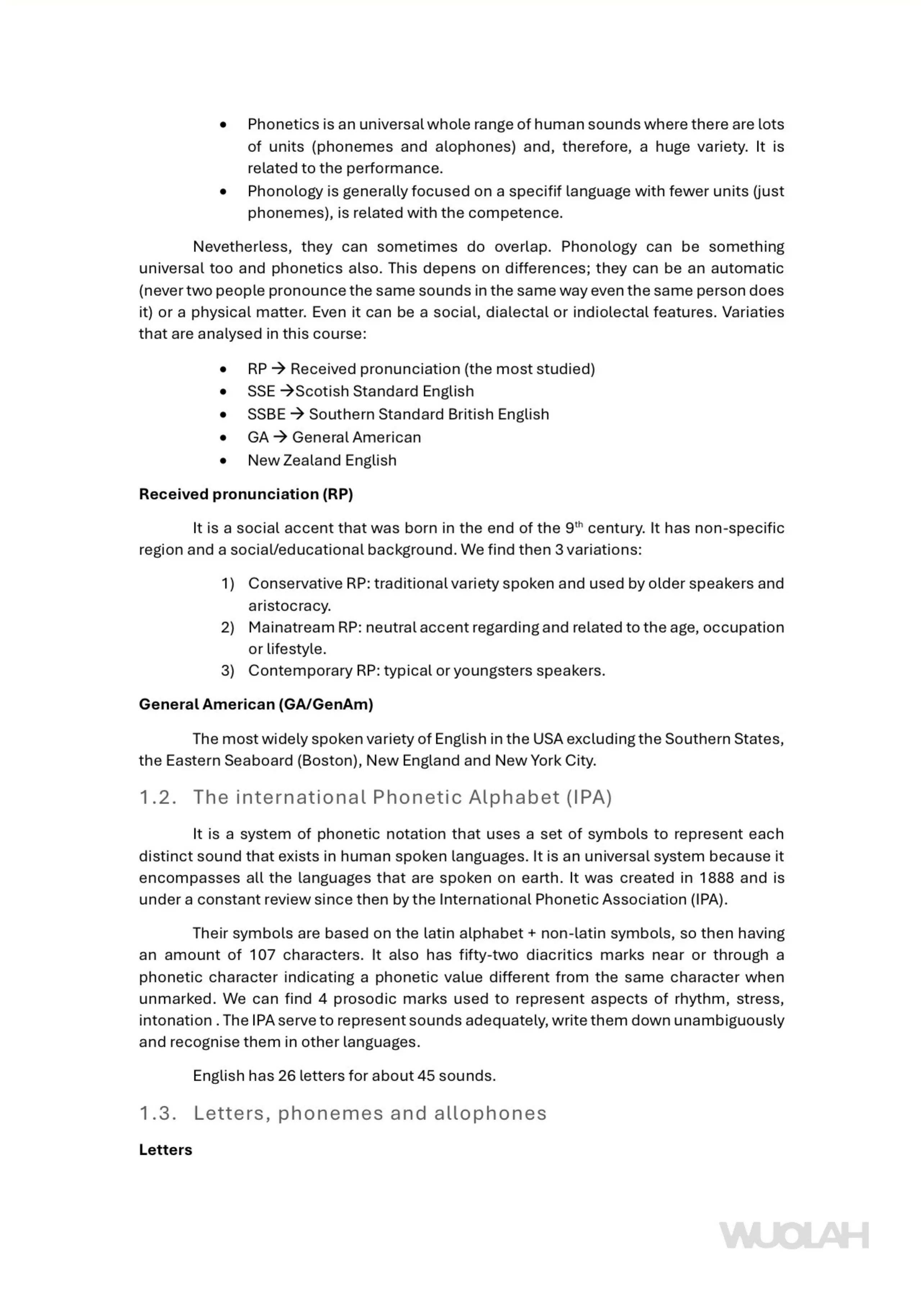Unit 1: Introduction to phonetics and phonology by Wuolah
Document from Wuolah about Unit 1: Introduction. The Pdf, a university-level resource for Languages students, delves into phonetics and phonology, exploring human speech mechanisms and the International Phonetic Alphabet.
See more19 Pages


Unlock the full PDF for free
Sign up to get full access to the document and start transforming it with AI.
Preview
Unit 1: Introduction
Phonetics and phonology
The language has its differents branches and is composed by: Systems of symbols Human communication Abstract>independent of speakers and it is related with the competence (ability of using a language) > Arbitrary-> it is the shape, sound (signifier) and meaning, concept (signified) which are related to the performance (the usage of the language) Phonetics and phonology are both two subdisciplines that deal with sound. They focus on them in differents ways though: Phonetics provides objective ways of describing and analysing the range of sounds humans use in their languages. More specifically, articulatory phonetics identifies precisely which speech organs and muscles are involved in producing the different sounds of the world's languages. Those sounds are then transmitted from the speaker to the hearer, and acustic and auditory phonetics focus on the physics of speech as i travels through the air in the form of sound waves, and the effect those waves have on hearer's ears and brain. It follows that phonetics has strong associations with anatomy, physiology, physics and neurology. To sum up, it is related to the performance observing directly the speech sounds and physical properties. It provides tools to describe the whole range of human sounds. Their transcriptions are represented by square brackets [ ... ]. The domain of phonology is the language-specific selection and organisation of sounds to signal meanings. Phonologists are interested in the sound patterns of particular languages, and in what speakers and hearers need to know, and children need to learn, to be speakers of those languages: in that sense, it is close to psychology. It is related to the competence and transcriptions are done with slanted brackets / ... /. Phonology and phonoligysts observe speakers' behaviours in order to settle generalisations and explain how the specific language is organised and its system beacuses, us as native speakers, we know our language but we can not explain it professionally. In this way, then the exceptions come up. Inside phonology, we have some phenomenes:
- Accidental gaps: those are sound combinations that could exist but they do mean nothing. This happens with the sound /snif/. It is technically possible but has no meaning.
- Systematic gaps: those are sound combinations that can not technically exist either has meaning. In English, for instance, the sound /kn/ highly characteable from German, does not exist either in English either in Spanish.
In this point, we can establish differences between phonetics and phonology WUOLAH. Phonetics is an universal whole range of human sounds where there are lots of units (phonemes and alophones) and, therefore, a huge variety. It is related to the performance.
- Phonology is generally focused on a specifif language with fewer units (just phonemes), is related with the competence.
Nevetherless, they can sometimes do overlap. Phonology can be something universal too and phonetics also. This depens on differences; they can be an automatic (never two people pronounce the same sounds in the same way even the same person does it) or a physical matter. Even it can be a social, dialectal or indiolectal features. Variaties that are analysed in this course:
- RP -> Received pronunciation (the most studied)
- SSE >Scotish Standard English
- SSBE -> Southern Standard British English
- GA > General American
- New Zealand English
Received pronunciation (RP)
It is a social accent that was born in the end of the 9th century. It has non-specific region and a social/educational background. We find then 3 variations:
- Conservative RP: traditional variety spoken and used by older speakers and aristocracy.
- Mainatream RP: neutral accent regarding and related to the age, occupation or lifestyle.
- Contemporary RP: typical or youngsters speakers.
General American (GA/GenAm)
The most widely spoken variety of English in the USA excluding the Southern States, the Eastern Seaboard (Boston), New England and New York City.
The international Phonetic Alphabet (IPA)
It is a system of phonetic notation that uses a set of symbols to represent each distinct sound that exists in human spoken languages. It is an universal system because it encompasses all the languages that are spoken on earth. It was created in 1888 and is under a constant review since then by the International Phonetic Association (IPA). Their symbols are based on the latin alphabet + non-latin symbols, so then having an amount of 107 characters. It also has fifty-two diacritics marks near or through a phonetic character indicating a phonetic value different from the same character when unmarked. We can find 4 prosodic marks used to represent aspects of rhythm, stress, intonation . The IPA serve to represent sounds adequately, write them down unambiguously and recognise them in other languages. English has 26 letters for about 45 sounds.
Letters, phonemes and allophones
Letters
WUOLAHLetters can be defined as graphemes that serve the porpuse of representing sounds ("witten symbols") normally based on the phonemes of a language. We represent them between angular brackets <... >
Phonemes
They are the smallets sound units in a language that has the ability to convey meanings. They are abstracts units representing sounds in an ideal mode. If they are substituted by another, the meaning of the word changes. We represent them between slante brackets / ... /
Allophones
They can be defined as differente actual realizations or variations of a phoneme. They are represented between square brackets [ ... ]. To qualify as allophones of a same phoneme, the sounds must meet two criteria: They must occur in exclusive and predictable mutually contexts. The use of the allophones does not result in a change in meaning. V Their perceptible differences are not relevant for particular porpuses. Final remarks It is important and necessary to take into account that each language has its own phonology and phonetics so, maybe, a phoneme in one language might be an allophone in another one or vice versa. It even can be possible that a simple sound in our language is a registered sound in other language.
Unit 2: Human speech mechanism
Speech phases
- Psychological phase: It occurs in the brain of the speakers when they decide to formulate a concept.
- Physiological phase: it occurs when the nervous system transmits the order from the brain to the speech of organs.
- Physical or acustic phase: it occurs in the air when the movements of the organ speech produce disturbances.
Organs
Speech requires the coordination of many organs (tongue, lips, teeth, etc ... ) and breathing.
Breathing
Most vocal activity is produced with an eggresive (pulmonic) airflow; this means that the airstream is expelled from lungs ouwards. However, some languages also have ingressive airflow, sounds which do not require air coming from the lungs for their articulation (inwards).
Larynx, vocal folds, glotis and trachea
The larynx is a casing formed of cartilage and muscles. Inside, the vocal folds are that are ligaments of elastic tissue which may be brought together or parted. When we speak, they can vibrate. The glottis is the opening within the folds. When we breathe, it is widely open. For some sounds, specifically glotal stop ones, they are completely closed. It is partially open for the most sounds with vibration (voiced sounds) or with no vibration (voiceless sounds). The trachea or windpipe is the organ where the air-flow from the lungs goes through to arrive to the larynx. The velum or soft palate is the organ that allows the air to escape through the mouth if it is not raised; if it is raised, the air escapes through the nostrils. Considering this, we distinguish two sounds: Oral sounds: they are the ones produced when the airstream coming from the lungs goes through the trachea, the larynx and the pharynx and ends up reaching the mouth and the lips. This occurs when the velum is raised Nasal courds: they are produced by the stream of air ending up in the nise and being released through the nostrils. This occurs when the velum is lowered.
The airflow
Igressive sounds in English
- Tut-tut sound: a dental or alveolar click that expresses annoyance, impatience, disapproval or pity. It is not a phoneme and is used paralinguistically.
- A lateral click: The sound made to encourage horses.
- Bilabial click: the kissing sound.
Lateral vs central release
WUOLAHLateral vs central release All the sounds are centra, except /l/ that is lateral. This means that the airstream is released alomg the sides of the tongue, while the other sounds are released the air centrally.
Sonority
When sounds are produced, the vocal cords are pulled back and drawn apart leaving a space (partiallty open) for the air to flow. The vocal cords may vibrate or not. Therefore, if they do we have voiced sounds and if they do not, they are voiceless.
Unit 3: English consonants: descriptions & transcriptions; phonemes and allophones
Defining parameters
We use the followings parameters, and they should be in this order: 1) Oral/nasal 2) Voiced/voiceless 3) Place of articulation 4) Manner of articulation 5) Lateral/central
Place of articulation
There are two types of articulators when producing a sound:
- Active ones: those that can move; that is to say, the bottom lip and tongue.
- Passive ones: those that cannot move; (upper lip, teeth, palate and alveoli) In order to produce a consonant, the active articulators move towards the passive ones; where that happens determines the place of articulation. For English consonants, we have 8 places of articulation: Post-Alveolar Palatal Velar Alveolar Bilabial Glottal Labiodental Dental
- Bilabial: a bilabial sound is when the bottom lip (active) and the top lip (passive) meet. Labiodental: a labiodental sound is when the bottom lip (active) and the upper front teeth (passive) meet. Dental: a dental sound is when the tip of the tongue (active) and the upper front teeth (passive) meet. Alveolar: an alveolar sound is when the tongue tip or blade (active) and the alveolar ridge (passive) meet. Pos-alveolar: a post-alveolar sound is when the blade of the tongue (active) and the adjoining parts of the alveolar ridge and the hard palate (passive) meet. Palatal: a palatal sound is when the front of the tongue (active articulator) and the soft palate (passive) meet. Velar: a velar sound is when the back of the tongue (active) and the velum or soft palate (passive) meet. Glottal: a glottal sound is when the vocal cords and the tongue is not involved.